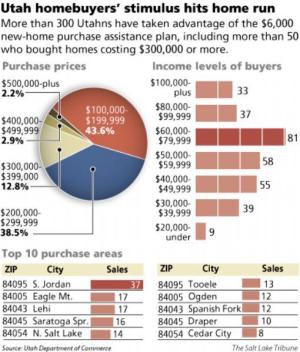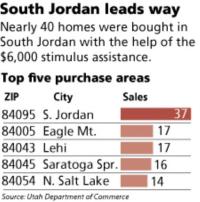by EDCUtah
Just 32 miles southwest of Salt Lake City lies three of Utah's best kept economic development secrets: Tooele County, Tooele City and Grantsville. While the silver and gold mines that drew settlers there in 1849 have long since been quieted, the area is booming and its future couldn't look brighter.
"If I had a dozen shovel-ready industrial parks I could fill them in no time," says Tooele County Economic Development Director Nicole Cline. "Tooele County was once a big secret, but we are now inviting the world."
Primed for Growth
The positive economic development outlook expressed by Cline is equally felt by Tooele Mayor Patrick Dunlavy and Grantsville Mayor Byron Anderson, both of whom are aggressively pushing economic development initiatives forward in their respective cities.
"We think we do economic development really well here," says Mayor Dunlavy. "We've had significant successes over the years and feel really good about the direction the city is going. After his election, the Mayor made job creation a high priority for his office and the city council bought in. "We're all on the same page," he says.
Tooele City is home to the Utah Industrial Depot, one of Utah's premier shovel-ready economic development sites and a prime location for manufacturing and light industrial concerns. Six additional industrial parks are in various stages of development within the area--one in Grantsville, four in the county, and one in Tooele City, being constructed near the Miller Motorsports Park (MMP).
Utah Industrial Depot
The Utah Industrial Depot is a shovel-ready park that sits on 1,400 acres of land formerly used as a military truck refurbishing center for the Tooele Army Depot. The Depot is now a private facility with 2.5 million square feet of competitively priced warehouse and manufacturing space. Some 65 companies currently operate from the Depot, employing approximately 1,100 people. Dunlavy says the Depot is an attractive location because it is comprised of both buildings and improved land with rail service, and can accommodate manufacturing, distribution and light industrial uses.
Last April, Cicero, NY-based Syracuse Castings, a manufacturer of steel, aluminum, and cast iron products for the construction industry, announced it would open a manufacturing operation in the Depot. The new 20,000-square-foot facility represents a $2 million investment by the company and could employ upwards of 90 people within the next five years. Other businesses to recently locate at the Depot include Carlisle SynTech and its Hunter Panels subsidiary, which are part of North Carolina-based Carlisle Companies. Carlisle SynTech and Hunter have built adjacent factories on a 50-acre parcel. Carlisle SynTech manufactures single-ply roofing products and systems and is opening a facility to manufacture its Sure-Weld TPO membranes and accessories. The 250,000-sq. ft. facility is the company's fourth roofing membrane plant in the U.S.
Retail Development
Because a large portion of Tooele Valley residents commute to the Salt Lake City for employment and much of their shopping, both Mayor Dunlavy and Mayor Anderson feel a strong desire to create jobs in their respective cities and both cities are working to build up their retail sectors as well. Tooele City actively participates in the Utah Pavilion at the annual convention of the International Council of Shopping Centers (ICSC) in Las Vegas. Typically Mayor Dunlavy and most, if not all, of the Tooele City Council attend, where they meet with selected retailers in pre-arranged meetings and recruit other targeted retailers at the convention.
Past efforts at ICSC have been quite successful, Dunlavy says. Through ICSC and a lot of additional follow up, the city recruited Big 5, a sporting goods retailer. Initially the Big 5 corporate office wasn't interested in the city, but later changed its mind. The store opened in November 2008 and now ranks ninth in gross sales out of the 395 Big 5 stores in operation, according to Dunlavy.
The city also recruited a Gold's Gym, which helped strengthen Tooele's downtown redevelopment efforts by remodeling an old Albertson's grocery store. Dunlavy says the gym reached $1 million in membership faster than any other store in the chain's history. The city also recruited a Sears store, which opened last December, and is pursuing other targeted retailers at the upcoming ICSC convention in May.
"We really see the value of ICSC. We go with a pre-set strategy; we have pre-set appointments with targeted companies, and work really hard for three days there."
Randy Sant, economic development director for Tooele, has high praise for Tooele City officials: "The mayor and city council really understand what economic development is all about. They understand the need for incentives and infrastructure in order to be competitive in this market and they have worked hard to be ready for the onslaught of companies coming to the area."
Grantsville City is Open for Business
"Any time a business looks like a fit, we go for it," says Mayor Anderson. "Grantsville is an idea place to locate, with close proximity to I-80 and rail lines, attractive land prices, nice people, a rural lifestyle and exceptional recreational opportunities."
Anderson served on the city council before being elected mayor and has developed a strong commitment to economic development in Grantsville.
"We are trying to bring in more business and retail development, so that our residents don't have to look in Tooele and Salt Lake City for their employment or shopping needs. We have two strip malls, but we are looking for something larger, like a hotel and restaurants to locate here."
Four years ago Grantsville landed a Wal-Mart distribution center and approximately 800 jobs. At full build-out the distribution center could employ 1,000 workers. The city is currently working with EDCUtah and Tooele County to recruit several other large businesses to the area, all of whom would provide a good mix of jobs, investment and opportunity.
Anderson says economic development is underway in other parts of his city, as well. One property owner is drawing up plans to create an industrial park and the city is actively promoting retail development.
Tooele Valley Amenities
The amenities that make Tooele County, Tooele City and Grantsville attractive locations for business are lengthy and impressive:
* Exceptional logistics: easy access to Salt Lake International Airport, rail lines leading to Reno and Las Vegas, Nevada, and close access to I-80.
* Quick access to the I-215 corridor (and avoidance of I-15 gridlock).
* A young, skilled workforce. Median age is 28.
* An educated workforce--Utah State University's Tooele campus is booming and many of Tooele School District's high school graduates earn associate degrees in conjunction with their high school diplomas.
* Location of an Advanced Technical Center and Custom Fit Program.
* Large tracts of land available for development.
* Land use regulations that are pro business.
* Accelerated permitting processes.
* Attractive land prices.
* Hub zone designation, giving businesses preferential contracting rights through the federal system.
* Three military bases located in the county: Dugway Proving Ground, Deseret Chemical and Tooele Army Depot.
* More enterprise zones in Tooele County than any other county in the state.
* Location of the Miller Motorsports Park.
Such amenities drew Pittsburgh-based Allegheny Technologies, a manufacturer of specialty metals, to the county in 2008. The company built a $250 million titanium sponge production facility in Rowley and employs approximately 250 people there.
Miller Motorsports Park
Those same amenities helped make Tooele County an attractive location for the Miller Motorsports Park, the $100 million auto, motorcycle and kart racing facility opened in 2005 by the late Larry Miller. The MMP could one day make Tooele County the motor sports capital of North America. It happens to be the largest race track of its kind in North America and due to its size and versatility, is drawing interest from more than just race enthusiasts. Cline says automotive companies and developers of unmanned vehicles want to utilize the test track for their development purposes.
"All in all, the Tooele Valley represents one of the most attractive locations in the western US. We have had great success working with all the communities in the region and look forward to continued recruitment activity in the area," says Jeff Edwards, president & CEO of EDCUtah.
Labels: Utah economic development, Utah economy, Utah market, Utah recognitions





